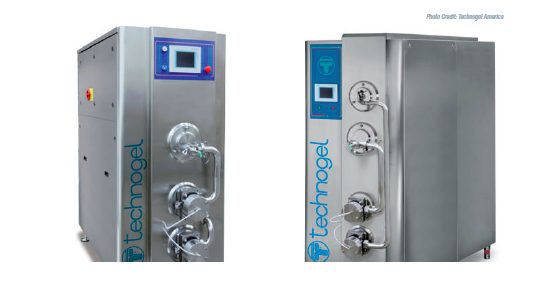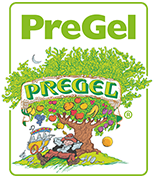
“How to Become a Gelatopreneur with PreGel” is the title of the three-minute edutainment short hosted on www.pregelamerica.com, PreGel America’s website, explaining that the upfront cost of a starter business can range from anywhere between $100K-$200K due to everything from building costs to equipment essentials such as immersion blenders, batch freezers, display case(s), refrigerators, and freezers. Despite the cost, this is your dream. You take the leap; make the investments; and nurture the business with passion and drive, taking it to a level of success that beckons you to now expand your business. You wonder what the next steps entail. In this instance, a variety of points must be considered including the expansion of commercial space and perhaps an upgrade to heavier duty equipment. For example, going from a regular batch freezer to a continuous freezer may be an option owner/operators might consider investigating.
I already have a batch freezer; how is it different from a continuous freezer?
Both pieces of equipment are essential to frozen dessert production, though their differences vary just slightly. Continuous freezers are true to their name; they are industrial freezers that continuously produce endless gallons of frozen dessert without interruption. In contrast, batch freezers are more commonly utilized to produce small batches of frozen desserts, making up to only 6 gallons of finished product. Batch freezers are ideal to have on hand for the creation of different flavors of desserts in more gourmet environments, but industry experts advise growing companies to invest in bigger equipment.
Craig French, CEO North American Operations, Technogel America, suggests that the addition of continuous freezers are essential for business types such as industrial companies, very high-volume stores; owners/operators who are looking to reduce labor, utility costs and increase volume, businesses either transitioning into wholesale or are already in wholesale but looking to evolve, or companies that have already cultivated a strong reputation for doing well.
The idea of transitioning to continuous freezers is met with apprehension at times, mainly because of their common association with the production of ice cream. However, French offered some enlightenment on this topic, saying “Based on my experience in listening to customers taking their businesses to the next level is the misconception that they cannot achieve artisanal gelato using industrial equipment. A lot of people have been taught and instructed that to get pure artisanal gelato, you have to run it in a batch freezer,” French explains. But because some manufacturers teach classes on an individual basis to educate possible customers more about how to use continuous freezers, they are actually able to see their gelato base run through a continuous freezer, thereby easing any initial apprehension.
So, if continuous freezers are not just for ice cream,
how do they work?
Continuous freezers showcase supreme efficiency for the high-volume production of milk- and water-based frozen desserts mostly due to these industrial machines being automated, thanks to Clarence Vogt of Louisville, Kentucky, who invented continuous freezers in 1926. For the frozen dessert production industry, this is where reducing labor, utility costs and increasing volume
came in.
The basic functionality of the continuous freezer scrapes frozen mix from the inside of a drum and pumps air into the mix as it freezes. The process improves heat transfer and allows for higher volumes of air whipped into the mix — a process that produces a continuous stream of product and allows accurate control
of overrun.
In reference to the efficient method in which continuous freezers work, online woodworking blog produced by the son of Vogt, www.ticovogt.com, published a statement of engineering praise from Tony Mathis, application engineer and product manager,  Vogt Freezers and the Votator, stating “Not only was it a continuous process so the benefits of mass production could be realized, but the ice crystals were so small that they gave an exceptionally smooth and creamy mouthfeel and they resisted freezer shock (formation of large ice crystals over time) much better than any other batch-wise freezing process.”
Vogt Freezers and the Votator, stating “Not only was it a continuous process so the benefits of mass production could be realized, but the ice crystals were so small that they gave an exceptionally smooth and creamy mouthfeel and they resisted freezer shock (formation of large ice crystals over time) much better than any other batch-wise freezing process.”
To this notion, French adds more validity, stating “The whole realm of producing with industrial machinery is to prevent any of those things from happening (recrystallization, iciness, etc.) due to the control you have over the machine.”
On the topic of having control over the continuous freezer, www.ecoursesonline.iasri.res.in,
an online catalogue of agricultural engineering courses, details the control functions of a continuous freezer. The informative digital resource explains that the modern ice cream freezer consists of a micro-processor programmed to control all the functions of operation including overrun, viscosity of product, cylinder pressure, all operating steps such as startup, routine or emergency shutdown, and resumption of operation after an automatic shutdown when the reason for shutdown has been corrected.
Additionally, the online catalogue reports that the micro-processor can show the time of day, mix flow rate, percentage of overrun, product rate, hours of operation, accumulated production in that time interval, the program step in operation, and various warnings.
The cautionary measures provided by the micro-processor function of a continuous freezer can benefit the operator in a way that prevents damage to the freezer in emergency situations, and help avoid decreased production time.
Furthermore, continuous freezers come equipped with an ingredient feeder, alternately known as a fruit feeder. This allows the controlled inclusion of fruit and chunky mix-ins such as cookies and brownies into the product subsequent to freezing. Operators of continuous freezers are warned not to add pieces of fruit or purees to the mix prior to freezing. Reasons include the potential for poor distribution in the frozen dessert due to residual pieces in the tank, left over particles dulling the scraper blades, or causing damage to the delicate internal fixtures such as pumps and seals.
Ofcourse proper care is necessary to maintain well-functioning machines, requiring them to be flushed out with a detergent and sanitized in the same process. Once a week, the pumps should be broken down, o-rings lubed and left to air dry, and then reconstructed the following day. With regular maintenance, a continuous freezer could see longevity upwards of 15 years.
What are some of the other advantages of investing in a continuous freezer?
According to French:
- Overrun can be set to your specs depending on the recipe, i.e., if you want a softer product to prevent air pockets and really fill the cups or harder products for decorative pans.
- They produce 20-25% better quality because you have the ability to control recipe, hardness, air, etc.
- You can take the same recipe and inject 30% overrun and still get that same consistency and more volume in a continuous freezer.
- Continuous freezers have a pump that pulls from a tank that holds as much base as the manufacturer makes.
- Continuous freezers can store up to 500 recipes so the varying results will maintain the same consistency each time.
- No spatulas are necessary; the continuous freezer can distribute finished product into pans, buckets, cones, pints, gallon buckets or whatever the maker desires.
- Speed components allow operators to fill packaging without becoming overwhelmed.
- Machines are self-cleaning as long as there is a water source that holds detergent.
- Production labor is cut by 2/3, requiring only one person to fill the tank with the base and the machine does the rest.
- Final product can be packaged and distributed on retail shelves outside of your establishment, allowing you to reach a potential greater audience, which could increase sales growth by leaps and bounds.
How will I know if it’s the right time to expand?
“If you have 3-4 batch freezers in your store, you’re working too hard and that’s when it’s time to transition to industrial machines,” French advises.
Switching from the artisanal mindset of producing to industrial requires many changes, but also delivers many benefits as well. For instance, as French explains “A shop can run for 4 days, working minimum 10-11 hours per day to make the gelato to supplement the store. With a continuous machine, you can work three 10-hour shifts and make all the gelato needed for the store, and still have back up.”
Keep in mind that even with the change in business you don’t have to completely sacrifice all the practices you’ve come to know. Expansion is important, but having the ability to make niche flavors in smaller batch freezers is best practice, especially if these are particular flavors that draw a substantial crowd.
If you get the feeling that it’s time to expand, ask yourself this question: what’s the next step to keep your business continuously churning along?
